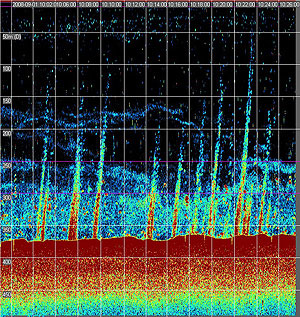Arctic warming already triggering methane release
The warming of an Arctic current over the last 30 years has triggered the release of methane, a potent greenhouse gas, from methane hydrate stored in the sediment beneath the seabed. Scientists at the National Oceanography Centre Southampton working in collaboration with researchers from the University of Birmingham, Royal Holloway London and IFM-Geomar in Germany have found that more than 250 plumes of bubbles of methane gas are rising from the seabed of the West Spitsbergen continental margin in the Arctic, in a depth range of 150 to 400 metres. Methane released from gas hydrate in submarine sediments has been identified in the past as an agent of climate change. The likelihood of methane being released in this way has been widely predicted. The data were collected from the royal research ship RRS James Clark Ross, as part of the Natural Environment Research Council’s International Polar Year Initiative. The bubble plumes were detected using sonar and then sampled with a water-bottle sampling system over a range of depths. The results indicate that the warming of the northward-flowing West Spitsbergen current by 1° over the last thirty years has caused the release of methane by breaking down methane hydrate in the sediment beneath the seabed. Professor Tim Minshull, Head of the University of Southampton’s School of
Ocean and Earth Science based at the National Oceanography Centre, says: “Our survey was designed to work out how much methane might be released by future ocean warming; we did not expect to discover such strong evidence that this process has already started.” …
Warming Ocean Contributes to Global Warming via Democratic Underground

This sounds like rather important news, that I have seen no where else. Thanks, ..I guess.